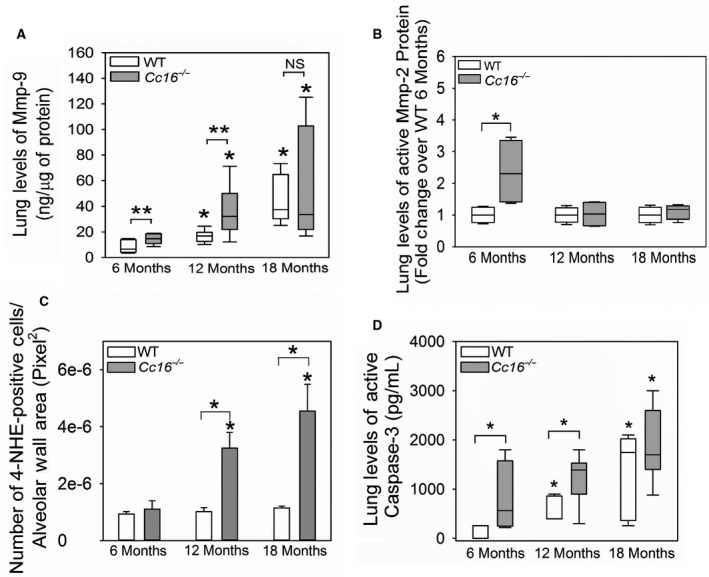Figure 5.

Greater lung levels of matrix metalloproteinases (Mmps) and oxidative stress and greater lung cell apoptosis develop in unchallenged Cc16 −/− versus WT mice. Lung levels of pro and active Mmp‐9 (A) and active Mmp‐2 (B) were measured in homogenates of lung samples from unchallenged WT and Cc16 −/− mice at 6, 12, or 18 months of age using ELISAs (5–9 mice/group) or western blotting (4 mice per group), respectively, and values were normalized to lung total protein levels. In (C), sections of inflated lungs harvested from 6‐, 12‐, or 18‐month‐old WT and Cc16 −/− mice (3 mice/group) were immunostained with a green fluorophore for 4‐hydroxy‐nonenol (4‐HNE) as a marker of oxidative stress and the number of 4‐HNE‐positively stained cells was counted per unit area of alveolar walls (measured in pixels2). In (D), active caspase‐3 levels cytoplasmic fractions of whole lung samples from unchallenged WT and Cc16 −/− mice at 6, 12, or 18 months of age (6–9 mice/group) using a quenched fluorogenic substrate that is specific for active capsase‐3, as described in Methods. In (A, B, and D), the boxes in the box‐plots show the median values and 25th and 75th percentiles, and the whiskers show the 10th and 90th percentiles. Data were analyzed using a one‐way ANOVA, and pairwise testing was performed using Mann–Whitney U tests. In (C), the bars represent the mean values and error bars represent SEM. Data were analyzed using a one‐way ANOVA, and pair‐wise testing was performed using Student's t‐tests. In (A–D), asterisk indicates P < 0.05 compared with mice belonging to the same genotype at 6 months of age, or the groups indicated; NS, not significant.
